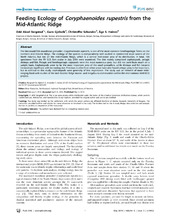Feeding ecology of Coryphaenoides rupestris from the Mid-Atlantic Ridge
Peer reviewed, Journal article
Accepted version
Permanent lenke
https://hdl.handle.net/1956/4343Utgivelsesdato
2010-05-03Metadata
Vis full innførselSamlinger
Originalversjon
https://doi.org/10.1371/journal.pone.0010453Sammendrag
The Macrourid fish roundnose grenadier, Coryphaenoides rupestris, is one of the most common benthopelagic fishes on the northern mid-Atlantic Ridge. The ecology of the species is comparatively well studied in continental slope waters of the North Atlantic, but not on the mid-Atlantic Ridge, which is a central mid-ocean area of its distribution. In total, 166 specimens from the RV G.O. Sars cruise in July 2004 were examined. The diet mainly comprised cephalopods, pelagic shrimps and fish. Pelagic and benthopelagic copepods were the most numerous prey, but did not contribute much on a weight basis. Cephalopods were by far the most important prey of the small grenadiers, while shrimps and fish became increasingly significant with increasing size. Previous studies from other areas have also found pelagic prey to be important, but in contrast to this study, cephalopods were generally of less importance. The study was an element of more wide-ranging food-web studies of the mid-Atlantic Ridge macro- and megafauna communities within the international MAR-ECO project.

